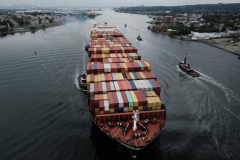In This Story
President-elect Donald Trump’s proposed tariffs are pushing companies to keep importing more goods, even as the pressure of a potentially devastating port strike has been lifted.
How Donald Trump’s tariff rhetoric could reshape investment strategies, according to a strategist
Retailers have been steadily increasing their imports over the last few months as they prepare for the upcoming administration, which has already been using the threat of tariffs to push for changes. On the campaign trail, Trump’s threats varied widely, and in recent weeks, he’s considered tariffs on several of the U.S.’s major trading partners.
His threats, combined with the threat of a now-unlikely massive longshoreman walkout across U.S. East and Gulf Coast ports, pushed imports to rise in double-digit percentages compared to last year, according to a new report from the National Retail Federation and international trade consultancy Hackett Associates.
“We have narrowly averted a strike, but that doesn’t mean there hasn’t been an impact,” Hackett Associates’ Ben Hackett said in a statement. “Importers had already front-loaded cargo in anticipation of delays, giving a boost to imports in December and early January.”
U.S. ports covered by the groups’ Global Port Tracker report handled 2.17 million twenty-foot equivalent units in November, or a 14.7% increase year-over-year. The report also projects that ports handled 2.24 million TEUs in December, marking a 19.2% increase, and 2.16 million TEUs in January, or up 10% compared to a year earlier. Traffic is set to slow down in February due to China’s Lunar New Year factory shutdowns.
The NRF’s vice president overseeing supply chains and customs, Jonathan Gold, noted that the agreement between the International Longshoremen Association and employers came at the last minute, so retailers had already been importing spring merchandise.
A strike was set for Jan. 15, when the latest extension of the union’s contract was set to expire. The two parties came to an agreement on Wednesday afternoon, saying in a joint statement that the deal is a “win-win” for workers, their employers, and the U.S. economy.
“The surge in imports has also been driven by President-elect Trump’s plan to increase tariffs because retailers want to avoid higher costs that will eventually be paid by consumers,” Gold said in a statement. “The long-term impact on imports remains to be seen.”
Trump has threatened universal tariffs of between 10% and 20% on all imports, although those plans may have been scaled back. After winning the presidential election, Trump threatened to hit Mexico, China, Canada, the BRICS geopolitical coalition, and the European Union with tariffs unless they complied with his varying demands.
Read More: Trump isn’t backing down from his tariff tough talk: ‘We have to take it seriously’
This week, Trump also refused to rule out hitting Denmark with tariffs, as he continues to talk about the U.S. purchasing Greenland, which is an autonomous territory of the Kingdom of Denmark, as well as Panama, as he eyes acquiring the Panama Canal. Trump has also floated making Canada a U.S. state.
The various threats make estimating the approximate impact of Trump’s tariffs difficult. However, the NRF in early November forecasted his proposals could cost consumers between $46 billion and $78 billion in annual spending power. Goldman Sachs (GS-3.37%) believes that a sweeping tariff would temporarily raise inflation to around 3% at its peak and could shave as much as 0.75-1.25 percentage points off GDP growth, depending on whether it is offset by other tax cuts.





